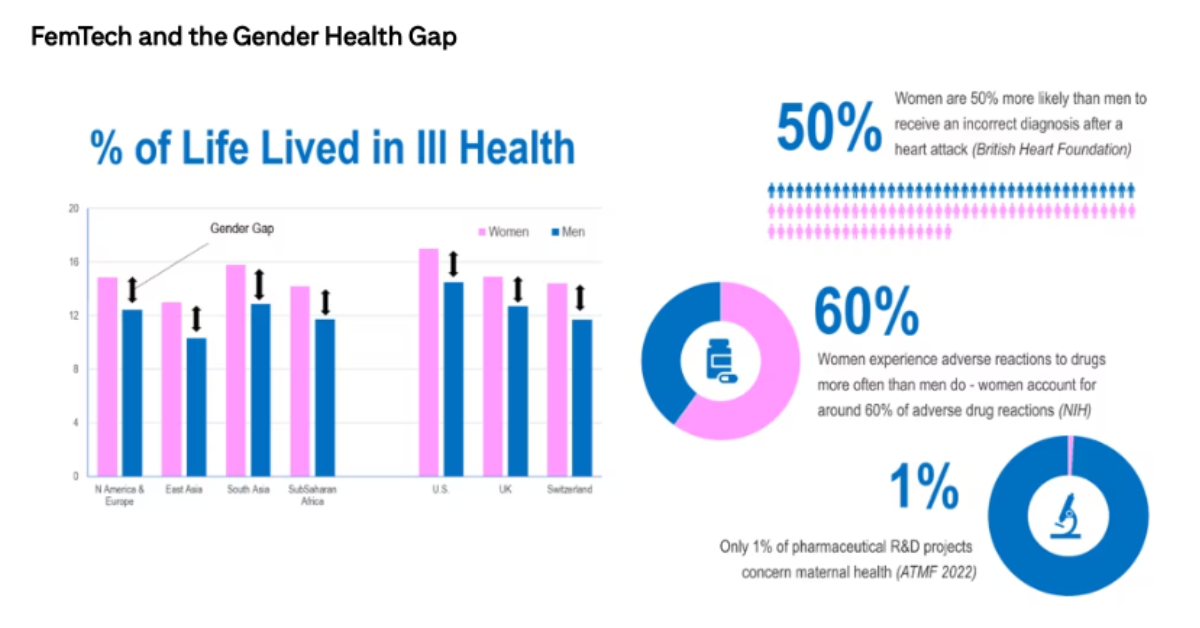
In November of 2023, President Biden announced the first-ever White House Initiative on Women’s Health Research. It’s mission statement makes note that “despite making up more than half the population, women have historically been understudied and underrepresented in health research.”
Throughout history, healthcare has served women less well than men. However, “FemTech” is a developing movement aiming to change this narrative.
In recent years, FemTech has emerged as a powerful and rapidly growing sector within the health technology landscape. Short for “Female Technology,” FemTech represents a range of software, diagnostics, products, and services that use technology to address women’s health needs. From fertility tracking apps to telehealth platforms specializing in gynecology, FemTech is driving a significant shift in how healthcare is delivered to women worldwide.
Below, we explore what FemTech is, its historical development, and the sectors of women’s health that it’s affecting.
What Is FemTech?
FemTech, coined in 2016 by Ida Tin, the founder of Clue, a period and ovulation tracking app, is an umbrella term for innovations that address women’s health and wellbeing. While health technology is not new, FemTech narrows the focus to the unique physiological and medical needs of women, a group often underrepresented in the general health tech sphere.
FemTech includes digital tools such as mobile apps, wearables, and telemedicine, as well as diagnostic devices, pharmaceuticals, and medical devices explicitly designed to tackle issues in women’s health. These innovations are tailored to a broad spectrum of needs, including reproductive health, menstrual health, pregnancy, menopause, pelvic and uterine health, sexual health, and general wellness.
Importantly, FemTech also extends into chronic conditions that disproportionately affect women, such as osteoporosis, autoimmune diseases, and mental health issues.

The History and Evolution of FemTech
While the term FemTech is relatively new, its roots can be traced back to earlier efforts in women’s health and technology.
The Roots of Women’s Health
The history of women’s health is marked by a long and often overlooked legacy of advocacy, innovation, and resilience. Though many advancements in women’s health are credited to more recent decades, the foundation was laid centuries ago by unsung heroes—women who, despite limited resources and knowledge, pioneered efforts to understand and improve the health and well-being of other women.
In ancient civilizations, women’s health was often entrusted to midwives and healers who relied on traditional knowledge passed down through generations, using natural remedies and rudimentary surgical techniques, which, while primitive by today’s standards, were groundbreaking in their time.
During the Middle Ages, much of the knowledge of women’s health was kept alive by midwives and nurses, who were often the primary caregivers for other women, especially in rural communities where access to trained physicians was limited.
In the 19th century, the push for women’s rights began to intersect more explicitly with health advocacy. Women like Elizabeth Blackwell, the first woman to receive a medical degree in the United States in 1849, fought to break down barriers in medical education. Her work, along with that of contemporaries like Florence Nightingale and Mary Seacole, expanded the understanding of women’s health beyond the reproductive system, emphasizing the importance of hygiene, nutrition, and preventive care. Blackwell and her peers advocated for women’s health education, laying the groundwork for public health movements that would follow.
The 20th century marked a period of more formalized advocacy. Women like Margaret Sanger campaigned for birth control access, while others fought for reproductive rights and better maternal healthcare. These efforts culminated in significant policy changes, like the legalization of contraception and abortion in many parts of the world. By then, the “tech” of the time had evolved from herbal remedies to surgical techniques and medical devices, reflecting a more nuanced understanding of women’s health.
Women’s Health Today and the Rise of FemTech
Historically, women’s health has been an underfunded and overlooked area in medical research. For decades, medical research prioritized male physiology as the “default,” leading to a significant knowledge gap regarding women’s unique health needs. This disparity affected everything from drug development to the diagnosis and treatment of conditions that primarily or exclusively affect women.
In fact, a recent report from Citi Global Insights emphasizes three specific aspects in which women still receive less effective healthcare compared to men: diagnosis, therapeutics and medications, and pain management.

Societal awareness of the gender health gap began to shift in the late 20th century, when the feminist movement and advancements in gender studies began to highlight these discrepancies. In 1993, the U.S. National Institutes of Health (NIH) Revitalization Act mandated the inclusion of women in clinical trials, marking a step toward addressing the gender gap in medical research.
However, it was not until the advent of digital technology and the rise of consumer-driven health solutions that the concept of FemTech truly began to take shape. The proliferation of smartphones, wearables, and data analytics aims to enable women to take more control over their health, creating fertile ground for FemTech innovation.
Since 2016, with the coining of the term FemTech, the movement has gained mainstream recognition, and investments in women’s health technology have begun to grow.
As of 2023, the global FemTech market is valued at over $22.5 billion and is projected to reach $60 billion by 2027.
FemTech’s Impact on Women’s Health
FemTech spans a diverse range of sectors within women’s health, each targeting specific areas of concern. The primary sectors include reproductive health, menstrual health, pregnancy and postpartum care, menopause, sexual health, general health and wellness, and chronic disease management.
FemHealth Insights’ 2023 FemTech Landscape Report shares that there are currently over 1,000 FemTech companies, with Mental Health, Menopause, and Chronic Conditions experiencing the highest growth in the past 5 years.
1. Reproductive Health
Reproductive health is one of the largest and most well-known areas within FemTech. This sector includes technologies that support fertility, contraception, and assisted reproductive technologies (ART) such as in-vitro fertilization (IVF). Fertility tracking apps, like Natural Cycles, provide women with tools to monitor their menstrual cycles, predict ovulation, and understand their fertility windows. Meanwhile, companies like Ava have developed wearable devices that monitor physiological markers to help with conception efforts.
FemTech companies are also innovating in contraception by developing new methods of birth control that are non-hormonal or that better suit women’s lifestyles. In assisted reproduction, digital platforms and telehealth services are improving access to fertility treatments and personalized care, which can often be costly and geographically restricted.
2. Menstrual Health
Menstrual health technology addresses the stigma and challenges associated with menstruation. FemTech companies are innovating with smart menstrual cups, period underwear, and sustainable sanitary products.
Apps like Flo and Clue help women track their cycles, manage symptoms, and predict menstrual health patterns. These innovations aim to normalize discussions around menstruation and provide more convenient, affordable, and eco-friendly solutions.
3. Pregnancy and Postpartum Care
FemTech also plays a crucial role in pregnancy and postpartum care. Platforms such as Ovia Health provide apps that guide women through every stage of pregnancy, from conception to postpartum recovery. These apps offer personalized content, track health metrics, and connect users with healthcare providers, providing support for physical and mental well-being.
Companies like Elvie have developed products such as wearable breast pumps and pelvic floor trainers that support women in their postpartum recovery. These innovations are designed to empower women to manage their own health during a vulnerable period, offering convenient, discreet, and efficient solutions for common postpartum challenges.
4. Menopause
Menopause is a natural phase of life that is often underserved in the healthcare market. FemTech companies are now stepping in to fill this gap by providing resources, apps, and products that help women manage symptoms such as hot flashes, mood swings, and sleep disturbances.
Midi Health is a virtual care clinic created by specialists in perimenopause and menopause on a mission to provide accessible midlife care to women. community support, and tracking tools for women navigating menopause, aiming to enhance their quality of life during this transition.
Evernow offers video visits with menopause clinicians, personalized care plans, prescription medications, and ongoing online and mobile support.
Apps like Caria and Stella offer personalized guidance, community support, and tracking tools for women navigating menopause, aiming to enhance their quality of life during this transition.
5. Sexual Health
Sexual health is another critical sector within FemTech, with companies developing solutions for sexual wellness, education, and dysfunction. From products like vibrators and lubricants to apps that promote sexual health literacy and consent education, this area addresses a broad spectrum of needs.
Companies like Wisp provide online same-day prescriptions, resources, and telehealth consultations to help women address sexual dysfunction and improve their sexual well-being.
6. General Health and Wellness
Beyond reproductive and sexual health, FemTech extends into general wellness, including mental health, nutrition, and fitness. Wearables and apps that monitor sleep, stress, and activity levels are increasingly being tailored to women’s unique physiological needs.
Companies like Bellabeat have designed smart jewelry that tracks women’s health metrics, encouraging a holistic approach to well-being.
7. Chronic Disease Management
Chronic diseases such as osteoporosis, autoimmune disorders, and cardiovascular diseases disproportionately affect women. FemTech companies are innovating in diagnostics and digital health platforms to support women with chronic conditions.
For example, telehealth platforms offer more accessible specialist consultations, while AI-driven tools assist in early diagnosis and personalized treatment plans.
The Future of FemTech
As FemTech continues to grow, it is poised to become a crucial part of the global health tech ecosystem. With increasing awareness and investment, the sector is expected to address more aspects of women’s health, including underserved areas such as menopause, chronic pain management, and mental health.
Future FemTech solutions will also leverage advancements in artificial intelligence, machine learning, and personalized medicine to provide even more tailored and effective care.
Conclusion
FemTech is more than just a trend; it represents a necessary evolution in healthcare that acknowledges and addresses the unique needs of half the world’s population. By focusing on reproductive health, menstrual health, pregnancy and postpartum care, menopause, sexual health, general wellness, and chronic disease management, FemTech offers innovative solutions that have the potential to transform women’s healthcare.
As this sector grows, it not only promises improved health outcomes for women but also challenges the broader healthcare industry to prioritize inclusivity and equity.
Sources:
NCBI: American Journal of Public Health. Women Healers of the Middle Ages: Selected Aspects of Their History. William L. Minkowski, MD, MPH.
National Women’s History Museum: Elizabeth Blackwell.
PBS: Margaret Sanger (1879-1966)
JAMA Network: Saints and Sinners: Women and the Practice of Medicine Throughout the Ages
Citi: Women’s Health: FemTech and the Gender Health Gap
FemHealth Insights: 2023 FemTech Landscape Report